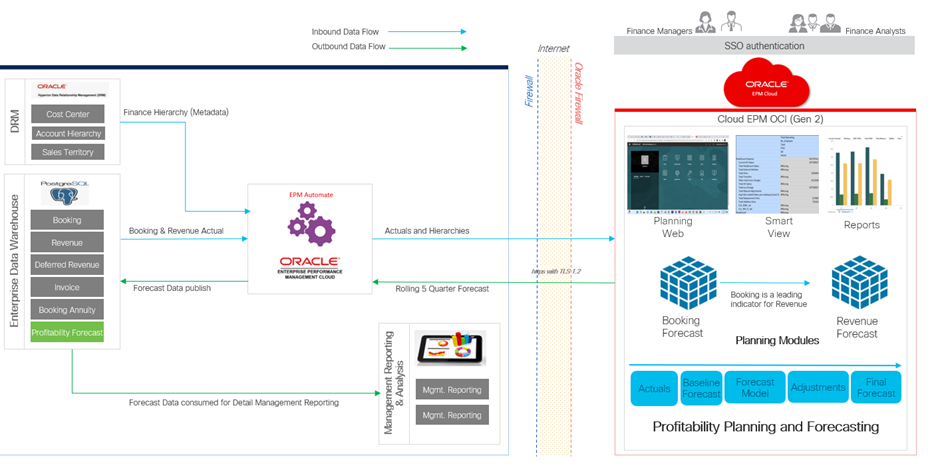Cloud technology has evolved from a buzzword to becoming fundamental to modern business operations. While many financial planning and analysis (FP&A) teams recognize the potential of cloud adoption, they often seek clarity on its specific benefits. As organizations embark on their Oracle Cloud Enterprise Performance Management (EPM) journey, it is critical to build a holistic strategy that leverages cloud as a transformation agent to drive business value, ensures operational readiness for the target-state architecture, and addresses financial challenges required for the transformation.
Cloud EPM as a transformation agent
Oracle Cloud EPM enables organizations to reinvent themselves and their operations. While cloud technology offers clear infrastructure cost benefits, its true value lies in creating new opportunities for innovation and efficiency. Many companies take a “lift-and-shift” approach to cloud migration, which often fails to capitalize on the cloud’s transformative potential.
At Cisco, we chose to bypass traditional on-premises implementations and moved directly to implement Oracle Cloud EPM capabilities. This bold approach reflected our commitment to innovation and agility and helped us build a compelling business case while and avoiding the fatigue often associated with gradual cloud transitions.
Key innovations of Oracle Cloud EPM Planning
Oracle Cloud EPM Planning delivers several transformative capabilities that revolutionize financial planning, budgeting, and forecasting.
- Unified platform for financial planning: Oracle Cloud EPM Planning provides a single, consolidated platform for financial planning, forecasting, and reporting, enabling organizations to manage their entire planning process in one place. This reduces the complexity with multiple systems and improves cross-departmental collaboration.
- Predictive analytics and AI/ML-driven insights: Leveraging machine learning and AI, Oracle Cloud EPM Planning offers predictive capabilities that help FP&A teams identify trends and make data-driven decisions. These insights help businesses anticipate financial outcomes, enabling proactive rather than reactive planning.
- Scenario modeling and driver-based planning: One of the most valuable innovations in Oracle Cloud EPM is the ability to create detailed scenario models and perform driver-based planning. This allows organizations to model different business scenarios (such as changes in sales, costs, or market conditions) and understand their impact on financial outcomes, leading to more informed decision-making.
- Collaborative, connected planning: Oracle Cloud EPM enables better collaboration between finance and other business units. By providing shared planning workspaces and workflows, teams can work together to create more accurate and aligned financial plans. This reduces silos and enhances alignment between strategy and execution.
Data integration architecture
Data integration forms the cornerstone of any Cloud EPM transformation, powering strategic decision-making through comprehensive insights. One of the most critical decisions in designing an integration architecture for cloud is choosing between a loosely-coupled and a tightly-coupled architecture, considering several key factors. While tightly-coupled architectures can be simpler to implement initially, they often incur higher long-term maintenance and upgrade costs. Loosely-coupled systems provide organic growth potential, whereas tightly-coupled systems might require comprehensive overhauls to scale. We made a deliberate decision to implement a loosely-coupled data integration architecture powered by Oracle EPM Automate and Cloud EPM APIs. This choice was not just about technology—it was about creating a future-ready foundation for our business. For instance, we automated the extraction of financial data from our data warehouse system and used the EPM Automate API for seamless transformation and ingestion into Oracle Cloud EPM for reporting and forecasting.

Figure 1. Data flow architecture
Performance
While organizations often focus on functionality and data migration, one critical aspect that ensures implementation success, but is often overlooked, is performance testing. Performance testing acts as the safety net that ensures your Oracle Cloud EPM solution performs optimally under real-world conditions, delivering a seamless experience for users and meets the demands of your business. The purpose-built tools within Cloud EPM test environments enable organizations to
- Simulate high volumes of concurrent users performing key tasks
- Test critical processes under peak load conditions
- Identify and resolve performance bottlenecks before go-live
A holistic approach to implementation
The key to successful transformation lies in adopting a comprehensive approach that:
- Aligns technology implementation with business objectives
- Ensures meaningful stakeholder engagement throughout the process
- Integrates processes seamlessly across the organization
Conclusion
Oracle Cloud EPM transformation represents more than a technical upgrade—it’s a strategic initiative that can revolutionize how organizations approach FP&A. Success requires careful attention to integration architecture, performance optimization, and change management. By taking a holistic approach that combines technical excellence with business strategy, organizations can leverage Oracle Cloud EPM to achieve greater agility, efficiency, and innovation in their financial operations.
The journey to a cloud-based EPM may seem daunting, but with proper planning and a clear understanding of organizational objectives, it becomes a powerful catalyst for business transformation. As demonstrated by Cisco’s experience, organizations that embrace cloud capabilities fully—rather than incrementally—often realize greater benefits and position themselves better for future growth and innovation.
